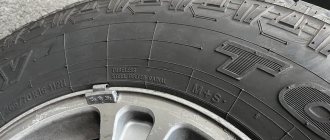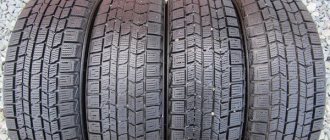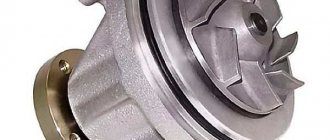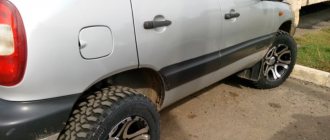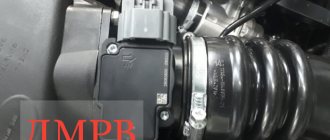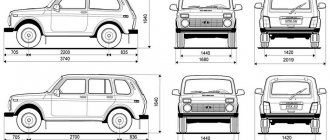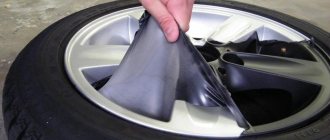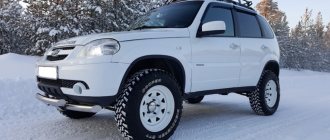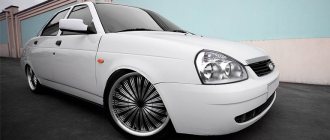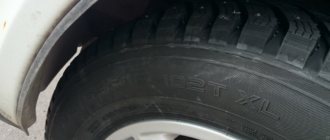Despite the fact that each car has its own recommendations for choosing tires, tuning enthusiasts often change the rubber profile.
In this article, we will take a closer look at the difference between regular and low-profile tires, and also provide recommendations for making the right choice.
rice. Low profile tires
What are low profile tires?
Let's remember the main parameters of the tire. There are three of them - the width and height of the profile, the diameter of the disk. They are interconnected, which complicates the selection and selection process. If you change one parameter, you have to change others.
This requirement follows from the need to maintain the height (diameter) of the wheel, which is recommended by the manufacturer.
The profile height parameter is equal to the ratio of the height and width of the tire.
The rubber profile is calculated using the following formula:
Tire profile = Height/Width* 100%.
The resulting value is not absolute, but only guarantees the relationship between two parameters - height and width. So, tires with the parameter 205/55 R16 have a lower side height than 225/55 R16.
So, what are low profile tires? This is a product (tire, tyre), the height of the side part of which (when measured from the road to the rim) is minimal in relation to the width of the tire.
Such tires are installed as standard on some high-end cars with a “sports bias”.
Low-profile tires are in demand among tuning enthusiasts who dream of changing their car, making it stand out from the “gray mass,” and achieving better sporting performance.
It’s worth noting that the concept of “low profile” has changed over the years. The tire market is regularly updated, new models appear with better characteristics.
In the 70s, tires with a profile of up to 80 were considered low profile. Today the approaches have changed. Low profile tires include tires up to 45-55.
Thus, in European countries, size 205/55 R16 is in demand among car enthusiasts.
The difference between the tire is the absence of a rib that would protect the disc. Therefore, such tires cannot be considered low-profile.
185/55 R15 is more suitable for the new concept.
But height is not the only distinguishing feature. Another criterion is the presence of a protective edge of the disk.
If we talk about the minimum parameters of such tires, then it is worth mentioning the ETRTO standards.
Since 2009, the European Wheel and Tire Manufacturer's Community has decided that a low profile tire is one with size 20 (example 375/20 R21).
But this is not the limit.
The companies Kumho and Nexen surprised the world with low-profile tires with sizes 385/15 ZR 22 and 365/15 ZR 24, respectively (models Ecsta SPT KU31 and N3000).
Why is it needed at all?
To be honest, now almost all tires can be called low-profile, because the width of the wheel will almost always be greater than the height of the cord. That’s why there are sizes with cord heights of 50, 55, 60, 65, 70, 75, etc. But it is very rare to find a tire where the height and width of the wheel were the same! Let's say R18 255/100, as is clear, the width here is equal to the profile height. These tires are used primarily on large SUVs, or all-terrain vehicles, for driving in marshy areas. Here is an example of Interco Bogger tires, its height and width are equal, this tire in the photo has a dimension of R16 255/100
BUT such tires in the city are useless, and I would even say harmful (using them in difficult - swampy - snowy areas)! After all, in the city, most of the roads are asphalted and smooth, and such tires will not allow you to move quickly and economically; the car will have to push this tire with force, because it is heavy and relatively soft and wrinkles very much (something like a pillow, due to the high profile). However, these types can withstand the maximum weight or load index, which is why they are installed on large vehicles (trucks, tractors, large buses).
That's why the second type was invented - a low-profile tire, specifically for urban use. After all, the lower the height of the wheel, the stiffer the wheel, and accordingly it rolls better, contributes to the stability of the car (especially in corners), and fuel consumption is also reduced (and decently). These types can be used to move quickly on asphalt roads; the speed index is usually quite high. But such rubber will not be able to support a lot of weight, it is not for commercial vehicles (almost always installed on passenger cars), it is absolutely useless off-road, all because it is hard, and the tread is not designed to “dig” dirt or snow. In general, my advice to you is not to get into serious mud with such tires, even if you have an all-wheel drive SUV!
Purpose
It is believed that low-profile tires are only for “show-off”. But that's not true.
As the speed characteristics of new cars increase, the requirements for tires and their braking characteristics also increase. The last parameter depends on the area of the tire’s “spot” with the road.
To reduce the braking distance, manufacturers increase the diameter of the disc, which leads to the need to reduce the profile height.
The speed index of modern low-profile tires ranges from 210 km/h or more (series “H”, “V” and above).
Read more about labeling here.
In addition, a car with low-profile tires does not sway as much when cornering, which gives it “sportiness” and controllability.
Low tires have the following advantages:
- increase the speed parameters of the car;
- make braking faster and more reliable;
- enhance vehicle stability during maneuvering and at high speed as well;
- provide a larger area of contact between the rubber and the road surface;
- provide quick acceleration from the starting point of the car;
- increase vehicle stability on sharp turns;
- are a decoration of the car, giving it an attractive and noble appearance.
What should the pressure be?
A logical question concerns pressure requirements. In the case of low-profile tires, this parameter is important. If you overinflate a tire, the level of comfort decreases and every bump makes your teeth chatter.
When the pressure in rubber decreases, the risk of overheating increases and the service life of the product decreases (high risk of damage).
To avoid problems, you should follow the recommendations of machine manufacturers. Some of them advise slightly increasing the pressure for such tires (by about 0.15-0.2 bar), but this condition is not necessary.
Pros and cons of low profile tires
Like any product, low-profile tires, in addition to undoubted advantages, also have no less obvious disadvantages. Considering the extreme loads to which such tires are subjected, their service life is significantly shorter than that of standard tires. This is especially felt on Russian roads. Also, do not forget about the increased load on the suspension and chassis elements of your car. The reason is simple - the car will feel all the unevenness of our roads much more sensitively, shock absorption will be practically absent. In general, you will have to say goodbye to comfort for the sake of the thrill of high-speed travel.
Advantages and disadvantages
To understand the relevance of purchasing low-profile tires, it is worth knowing their pros and cons.
We will pay special attention to each of the points:
1. Positive qualities:
- Improved speed characteristics. As mentioned, low-profile tires have a high profile level - 210 or more. If the tire is a sports type, then the speed index is higher;
- Change in appearance. There are car enthusiasts who install low-profile tires to transform their car and improve its appearance. Here we are talking about banal tuning without reference to changes in the main parameters of the vehicle;
- Clutch. Installing low-profile tires ensures reliable traction. This is true for a flat track and is noticeable when turning;
- Resistance to deformation. The tire's ability to change shape during sharp maneuvers depends on the profile height. As a result, the stability of the vehicle also increases. The car sways less when making turns, the body does not pull to the side;
- Reducing braking distance. As in previous cases, the quality is determined by the area of the “spot” of contact with the asphalt.
2. Negative qualities:
- Demanding requirements for road surfaces. The advantages of low-profile tires described above are offset when driving on uneven roads. It is believed that there is a direct relationship between the road surface and ride quality on low-profile tires;
- Short service life. Due to bad roads, tires with a low profile “live” less than their “brothers”;
- Risk of deformation during prolonged parking. If the car is not used for a long period, an unevenness (defect) appears where the tire touches the ground. This problem is noticeable immediately after leaving the garage and manifests itself in the form of steering wheel vibration and beating. There is no need to worry - in 99% of cases the problem goes away 3-5 kilometers after heating the rubber, but the fact itself is already unpleasant. But in 1% of cases (during extremely long parking), the tires have to be thrown away due to their unsuitability for use;
- Poor depreciation. Low-profile tires do not differ in the quality of shock absorption. This means that bumps and bumps are inevitably transmitted to the driver's body. So, when choosing such tires, you should be prepared for a decrease in comfort;
- Increased noise level is a disadvantage that is explained by the increased area of contact of the product with the road;
- Non-compliance with factory requirements. The design of the tires makes drivers rack their brains about purchasing rims;
- Reduced stability on wet roads. Due to the special tread and the use of soft rubber, low-profile tires behave unstably on wet roads;
- Difficult to install. Self-installation of low profile tires is not possible. Moreover, not all service stations can boast the equipment necessary to solve such problems.
General characteristics
You can find the differences between a low-profile tire and a regular tire by looking at the side surface of the wheel: that’s where the special markings are applied. This marking indicates the parameters of the tire, thanks to which you can always find out whether it is low-profile tires or not.
For example, let's take a typical 225/40R16 tire marking and try to decipher it:
- 225 is a number that determines the width of the tire in millimeters;
- 40 is the percentage ratio between the height and width of the tire. We get the profile height like this: multiply 225 by 0.4 and get – 90 mm;
- R is a type of rubber. In this case, this index indicates that the tire is radial.
- 16 – this value indicates the radius of the tire. In this case - 16 inches.
If once low-profile tires were considered to be tires whose percentage ratio of height and width did not exceed 0.8, now this value has decreased significantly. These days, low profile tires have a rating of less than 0.55.
Therefore, the 225/40R16 marking we reviewed has an obvious low profile, with a difference in width and height of only 40% (0.4).
For clarity, let's compare a tire labeled 195/45R15 with a tire labeled 205/45R15.
To do this, we will perform the calculations already known to us for both the first tire and the second:
As we can see from the calculations, the first category of tires is lower. The second type of tire has a higher profile height. The maximum permissible profile is considered to be tires whose height to width ratio corresponds to 0.2.
As the next difference between low-profile rubber and conventional tires, consider such a characteristic as the speed index (the maximum permissible speed for operating certain tires), which is also applied to the side surface of the tire.
For low profile tires this value exceeds 210 km/h, while standard tires have a speed index of no more than 190 km/h. In addition, low-profile tires have a special so-called “stiffening rib” inserted into them, which protects the wheel rim from possible deformation.
This “rib” is found only on low-profile tires. If there is no “rib”, it is no longer possible to classify the tire as low-profile.
How do low profile tires affect suspension?
A popular question that buyers ask is related to the effect of such tires on the vehicle's suspension.
There are two options here:
- The vehicle is designed to run on these tires - low profile tires are installed as original equipment. In such a situation, the car’s hardware is adapted to harshness and unusual operating conditions. At the same time, the stability and correct operation of key components is maintained;
- The car is not designed to accommodate low profile tires. In such a car, the suspension is not adapted to large tires and wheels. The result is suspension wear and rapid failure of parts. In addition, the use of low-profile rubber increases the risk of damage to the integrity of aluminum wheels. The protective edge of the rubber will not protect against destruction if it falls into a hole on the road.
Wear problem.
Each tire is manufactured in such a way as to guarantee stability and compliance with the main indices (speed, load).
Based on theory, low-profile tires last as long as a classic tire. But this is only in theory.
Aggressive driving, hitting curbs, falling into potholes, traveling at high speeds, hitting curbs are factors that lead to a decrease in the service life of the product.
We must not forget that low-profile tires are a sporty option, and therefore have a corresponding service life; they wear out faster.
Bottom line
Whether it is worth installing low-profile tires is decided by every car enthusiast, having weighed the strengths and weaknesses of this type of tire. The low profile, on the one hand, ensures good handling of the car and saves gasoline, but on the other hand, due to the poor quality of the roads, it will force you to repair the suspension and wheels more often. If the choice in favor of this type of tires is made, you need to adhere to a more careful and careful driving style when driving and monitor the tire pressure more often. It is not recommended for novice drivers to install such wheels on their car, as they may not survive until the next season of operation.
Add ProCrossovers to your favorites
Manufacturers and examples of models
Manufacturers classify tires as low profile if their height is 40-50 mm or less.
Well-known brands that produce low-profile rubber include:
- BFGoodrich is an American manufacturer that has been producing tires since 1910. It is distinguished by a wide range of products, focus on quality and production of tires for extreme operating conditions. Popular models of low-profile tires are BFGoodrich G-Force Winter (product parameters - 215/45 R17 91H XL), BFGoodrich G-Grip (tire parameters - 255/35 ZR19 96Y) and others;
- Bridgestone is a world-famous brand. Producing countries: France, Poland, Japan, Germany, Spain and others. The company has been operating since 1931. It is considered a pioneer in the production of radial tires and has earned credibility thanks to the production of tires for sports cars. Popular low profile tires are Bridgestone A001, Bridgestone B280. It is also worth highlighting the following models - Bridgestone B330, Bridgestone B330 EVO and others;
- Continental is a tire manufacturer originally from Germany. Today the company occupies a leading position in Europe. The company's factories are located in Sweden, Portugal, France, Chile, Belgium, Turkey and other countries. “Representatives” of low-profile tires - Continental ExtremeContact (parameters - DW - 245/35 ZR20 95Y), Continental ContiWinterContact (characteristics - TS 850 - 245/40 ZR18 97W XL FR) and others;
- Goodyear is a company that began operations back in 1989. Already in 1926 it was recognized as the largest manufacturer in the world, which maintains its position today. Examples of low-profile tires - Goodyear Wrangler F1 - 275/40 ZR20 102W, Goodyear UltraGrip Ice Navi Zea (specifications - 245/45 R19 98Q), Goodyear Wrangler F1 - 275/40 ZR20 102W;
- Pirelli is an Italian tire manufacturer headquartered in Milan. The brand began producing tires in 1972. Today the Pirelli company includes more than two dozen factories operating in 13 countries. The company produces tires for all types of vehicles - SUVs, special equipment, vans, cars and other equipment. Examples - Pirelli Winter SottoZero serie III (parameters -245/45 R17 99V XL), Pirelli Winter SottoZero serie III - 225/45 R17 91H and others.
What are narrow profile tires used for?
As a rule, such tires are installed on a car to improve sporting characteristics. The car moves faster and grip on dry roads improves. In addition, the narrow profile is used for tuning cars. If you want to change your car and make it stand out from the crowd of the same type, then this is one of the possible solutions.
As for the correct operation of such tires, drivers have many questions. For example, what pressure should low-profile tires have? Many tire shops simply don’t know how to pump low-profile tires and, to be on the safe side, set the tire pressure to 2.1-2.2 atm. As a result, the car runs on half-flat tires.
On average, it is recommended to pump at least 2.6 atm into tires for passenger cars. Depending on the tire parameters, the pressure of off-road tires can be 2.7-2.9 atm.
Another common question is low-profile winter tires. Is it possible to use such tires in winter or is it better to use standard ones? Winter tires differ from summer tires in the material they are made of (softer), the presence of studs, and the tread pattern. Accordingly, a narrow-profile tire is not suitable for driving in ice, heavy snow or on uneven and slippery roads. The wheels simply cannot withstand the “surprises” of winter, and any unevenness will fall into the hands of the driver.
Low-profile off-road tires are available for sale, and manufacturers also produce winter off-road tires. In any case, you should carefully select such tires for use in winter or in difficult road conditions.
Reviews
As for car enthusiasts who have tested the tires, opinions differ:
— Egor, 33 years old, Skoda Octavia.
“After installing low-profile tires, I noticed that the car became more stable on the road. When making sharp maneuvers at speed, the car almost does not roll to the side, and self-confidence appears. An important plus is the sporty appearance of the car. The only thing I’m not happy about is the decrease in the level of comfort, but I’m ready to put up with it”;
— Konstantin, 40 years old, Subaru Impreza;
“Installing low-profile tires made me quite nervous. The roads in our region are far from ideal, so the experiment had to be stopped after two months of use. An unpleasant surprise was a decrease in comfort and frequent breakdowns of suspension elements”;
— Egor, 35 years old, Mitsubishi Lancer;
“The installation of new tires allowed us to test the car for “strength” at a speed of 180 km/h. I'm satisfied with the result."
My experience of use and useful tips
As I already mentioned, on my Volkswagen Polo, like on most of the same ones, 195/55 R15 tires from the wonderful manufacturer Kama, with the wonderful name Euro, are installed from the factory. I can hardly contain my emotions))) What kind of a genius person thought of installing such tires on a budget car, with a 1.6 racing engine with 105 horsepower and an oak suspension.
He probably doesn’t even imagine that Russian roads are far from ideal, that the tires chosen in this way once again emphasize the rigidity of the already uncomfortable suspension. After all, almost all owners of a budget Polo sedan take ninety-degree turns at a speed of more than 100 km/h and cornering stability is extremely important to them, because if they let off the gas while cornering, another car can pass them.
And I would also like to say how the “sports” Kama reacts to large holes. That's right - another hernia, and in some cases we get a bent disc as a bonus. It is useless to repair large hernias, so you have to buy a new balloon. With a mileage of 15,000 km on summer tires, I already bought a new wheel and drove an alloy wheel. Yesterday I accidentally saw a new hernia again.
In order to somehow save the tires and wheels, you have to pump them up to 2.3 - 2.4 atm, and this does not add comfort and smoothness at all. I’ll probably get tired of this soon, and I’ll change the tires, buy 4 tires from a normal manufacturer (for example, Continental) of size 195/60 R15, and most likely 195/65 R15. This size, although larger than the standard one, I know for sure, will not hurt, since there is a Polo in the yard on such tires.
To summarize, I want to say that a low profile for everyday use on budget cars does not add much charm to the car, but it definitely adds hemorrhoids to the owner. In continuation of the topic there is material about what the air pressure in the wheel should be. I want to believe that the article turned out to be interesting and useful. See you soon!
Wide-profile low-pressure tires
The wheel with a wide-profile low-pressure tire has a large support area. As a result, a low specific pressure is created on the ground. This contributes to excellent shock-absorbing properties when driving on bad roads. Such tires are used on off-road vehicles operating on soft soils, as well as on agricultural vehicles.
Wide-profile low-pressure tires
Profile view
The warm season is coming, it's time to buy summer tires. And more and more often questions arise about the low-profile tires that are fashionable today: “What’s good about them? What are the disadvantages? Is it worth betting?
We answer all questions already asked and not yet asked at once. And we offer the reader material about everything that is useful and interesting to know about low-profile tires.
By definition, a low-profile tire is one whose profile height (cross-section) to width ratio is less than 80%. True, recently for passenger cars this concept has shifted somewhat: today, low-profile tires are called passenger tires with a profile height of 70 or less.
In the tire size marking, which looks like XXX/YY RZZ, the profile height occupies the second position YY (XXX is the profile width, ZZ is the inner diameter) and changes in steps of 5: for example, 75, 70, 65, 60, etc.
For the first time, low-profile tires for production cars appeared as a prototype in 1937; They were 88 series tires from Michelin. But public roads and the cars themselves were not ready to accept such tires. However, the race tracks immediately jumped on the idea. The entry to the highway took place in 1977, when Pirelli introduced its legendary P6 and P7 lines to the public. Since then, low profile has become increasingly popular and today almost every tire manufacturer has a low profile model.
The lowest profile tires are now offered by Pirelli, with sizes such as 355/25 R19 and 345/25 R20 in the Pzero Direzionale and Pzero Assimetrico range. Dunlop also offers its own options, presenting tires with sizes 305/25-ZR20 and 265/30-ZR20. Continental is not far behind, where in the 2Vmax line there are sizes 235/30 ZR 20 and 305/25 ZR 20.
The advantages of low-profile tires lie in their lower height, which results in less sway and drift of the body “on balloons” during high-speed maneuvers. The result is greater vehicle stability and sharper handling.
The disadvantages of low-profile tires also lie in their lower height. The lower the profile, the worse the tire absorbs uneven terrain, the greater the impact on the suspension elements, the greater the wear, the lower the comfort and smoothness of the ride.
The width of the tire profile also makes adjustments to handling and steering feel. Wider wheels provide better directional stability and better deceleration of the car when braking. But, at the same time, the steering wheel becomes heavier, which is most noticeable if there is no power steering and when rotating in place or at low speed during parking maneuvers.
In the vehicle instructions, manufacturers usually prescribe tires with a profile of at least 70.
When selecting tires for a car, it is worth considering that, given the same outer diameter, the lower the profile (thickness) of the tire is chosen, the correspondingly larger the inner seat diameter. For example, tires 175/70 R13, 185/60 R14 and 195/50 R15 are equally suitable for C-class small cars.
When changing tires with one profile height to tires with a different height, you will have to purchase new wheels to maintain the outer diameter of the wheels.
Low-profile tires are now also available for trucks, with a profile height of 60, 55 and even 50! Almost all the world's tire manufacturers who produce tires for commercial vehicles can find such models.
Prices for low-profile models, all other characteristics being equal, are higher. For example, if an R13 tire costs, on average, 1,500 rubles, then an R14 will cost 2,000-2,500, and an R15 will cost around 3,000-3,500 rubles.
– The decision about whether or not to install low-profile tires must be made based on the conditions in which the car will be operated. If you drive mainly on highways and want to experience high-speed “drive” on turns, then low-profile tires will come in handy. Moreover, in combination with an alloy wheel, such tires look very advantageous. But if you drive on country roads, travel a lot on regional roads, or simply prefer a quiet driving style, and for you, smoothness and comfort come first, it is better to take normal profile tires. In any case, it is more logical to stick to the golden mean. For example, for a C-class with standard R13 wheels, it is wiser not to chase the lowest profile options on R15, but to take tires on R14. And the aesthetics will not suffer, and the driving characteristics will have an optimal combination.
Source
Varieties
There is no specific classification applied to low profile tires.
Basically, such rubber is distinguished by profile size. According to current generally accepted standards, any tire with a profile of no more than 55% belongs to the category of low profile. Previously, a different standard was used, corresponding to 70%! And the current trends in the development of the tire and automobile industry will soon certainly lead to the fact that 55%! will no longer be considered a low profile, and the report will start with 50 or even 45%!
You can also divide tires by the pressure that should be inside the low profile rubber. Which pressure parameters are used depends on several factors.
What kind of tires is this
To a large extent, its emergence is caused by the development of a network of modern roads with high-quality surfaces. This tire has a lower profile than a traditional tire. The pioneer of serial production of low-profile tires was the Italian company Pirelli, which “shod” the Italian sports car Lancia Stratos in them. This happened in the last quarter of the last century. An unusual profile that was lower than the standard profile of racing cars of the time. The cars, whose wheels were fitted with low-profile tires, began to have a characteristic fast appearance.
In addition to the body design, it was provided with a new rubber profile on the wheels. Its height was significantly less than the width of the tire, and was no more than 2/3 of the width. The process of improving low profile tires continues in our time. Leading tire manufacturers are focusing their efforts on keeping their profile lower while keeping the width the same. This tire has an increased seat size. This makes it possible to use larger diameter wheels, which ensures a stable turning radius. It becomes possible to install higher power wheel brakes.
This is relevant when machines use more powerful engines capable of delivering high speeds.
We recommend: What kind of oil to pour into the engine
